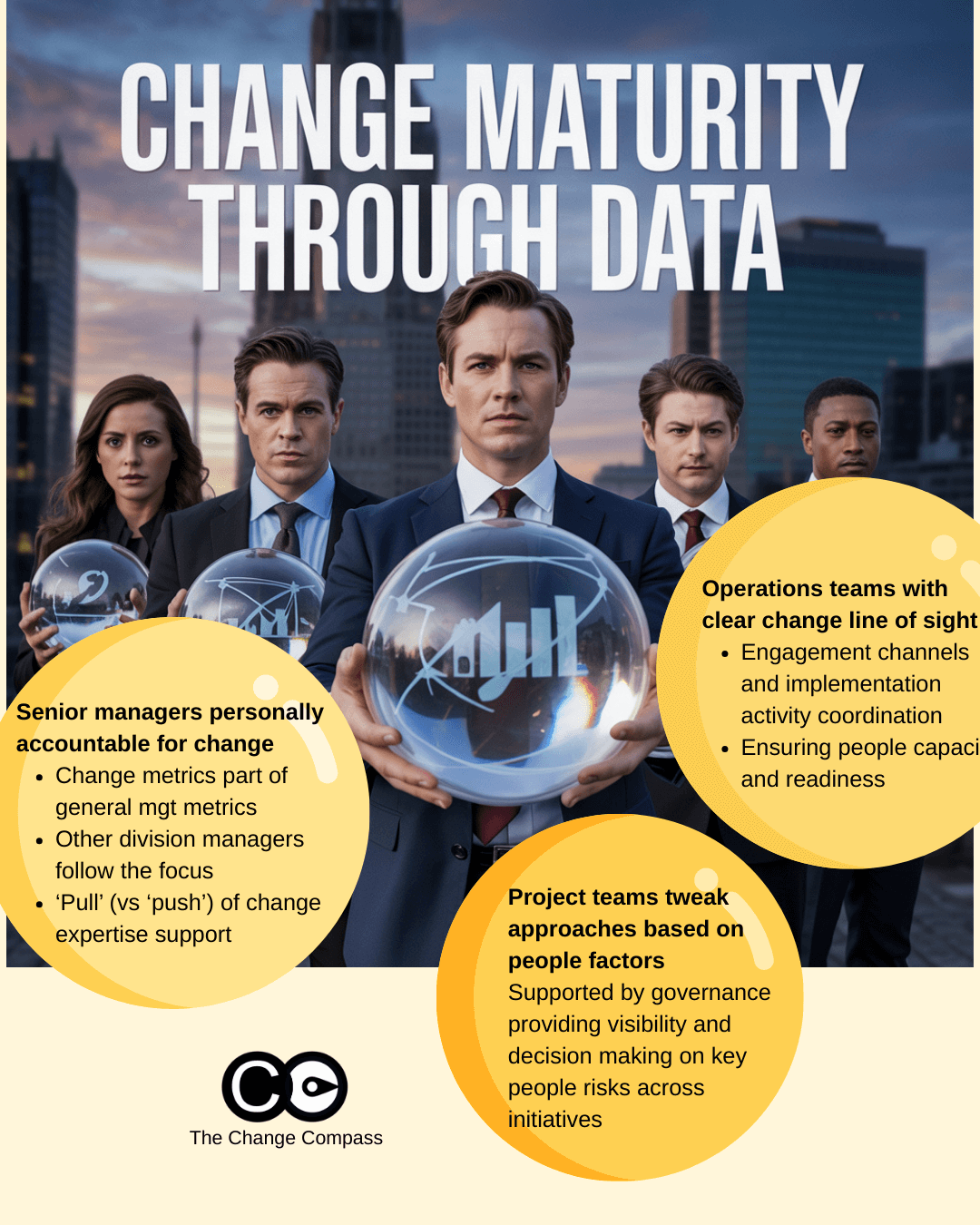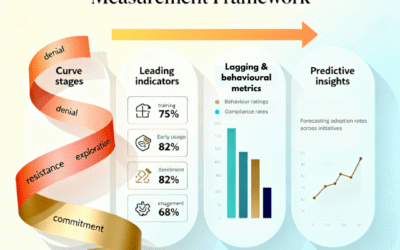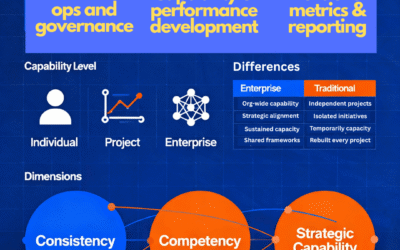Section 1: What Change Maturity Looks Like – And How Data Made It Real
Shifting from Capability Sessions to Data-Driven Change
For years, the default approach to improving organisational change maturity has been through capability sessions: workshops, training programs, and methodology deep dives. These sessions often focus on the mechanics of change management-how to assess impacts, create stakeholder maps, or run engagement activities. While valuable, they rarely move the needle on actual change maturity, because they don’t address the systemic challenge: embedding change into the rhythm of business.
This is not to say that capability sessions are inherently not valuable nor make an impact. The point is if this is the core approach to lift change maturity, you may want to re-think this approach.
In contrast, the financial services organisation we’re profiling achieved a step-change in maturity not by running more workshops, but by making change a measurable, managed discipline-driven by data. This is the essence of “what gets measured gets managed.” When change is tracked, analysed, and reported with the same rigour as financial or operational metrics, it becomes a core business focus and therefore evolving into a capability, not a project add-on.
The Hallmarks of Data-Driven Change Maturity
So, what does this maturity look like in practice?
- Senior Leaders Are Personally Accountable
Change metrics are embedded in the general management scorecard. Senior managers are not just sponsors; they are accountable for change outcomes, not just at a project level but within their business function. Their performance includes the outcome and the impact of change on business results. This accountability cascades throughout the organisation, with other managers following suit, creating a culture where change performance is a core management concern. - Demand for Change Expertise Is Pulled, Not Pushed
Instead of the central change team “pushing” support onto the business, managers proactively seek out change expertise. They do this because the data shows them where key risks and concerns are, making change support a value-added service rather than a compliance exercise. - Operations Teams Have Line of Sight
Operations teams can see all upcoming changes affecting their areas, thanks to integrated change visuals and dashboards. This transparency allows for coordinated engagement and implementation, ensuring that people capacity and readiness are managed proactively, not reactively. - Project Teams Adapt Based on People Data
Project teams don’t just track milestones and budgets; they monitor leading indicators like readiness, sentiment, and adoption. Governance forums provide visibility and decision-making authority on key people risks across all change initiatives, enabling real-time adjustments to project approaches.
The Data Infrastructure That Enabled This Shift
To achieve this level of maturity, the organisation should utilise a centralised change data platform, integrating inputs from project management and operational dashboards. Data governance was established at the management level, with clear ownership and enterprise definitions. Automation and AI were used to collect, cleanse, and analyse data at scale, removing manual bottlenecks and enabling real-time insights.
Contrasting Traditional and Data-Driven Approaches
| Aspect | Traditional Approach | Data-Driven Change Maturity |
| Senior Manager Involvement | Sponsorship, not accountability | Direct accountability, metrics-driven |
| Change Capability Uplift | Capability sessions, workshops | Focus on metrics improvement drove ongoing holistic capability improvement |
| Change Data Usage | Limited, ad hoc surveys or hearsay opinions | Integrated, real-time, enterprise-wide |
| Operations Visibility | Siloed, reactive | Proactive, coordinated, data-informed |
| Project Team Adaptation | Based on lagging indicators | Based on leading, predictive analytics |
| Value Realisation | Incremental, project-based | Enterprise-wide, transformative with alignment across different management levels |
The Real Work Behind the Results
Some might argue that this level of data infrastructure and governance is too complex or resource-intensive. However, with modern automation and AI, much of the data collection, cleansing, and analysis can be streamlined. The initial investment is quickly offset by the value unlocked-both in risk mitigation and in the ability to deliver change at scale, with greater precision and impact.
This is what change maturity looks like when it’s powered by data. It’s not about more workshops; it’s about making change visible, accountable, and actionable at every level of the organisation. The next section will explore how this approach transforms decision-making-from focusing on cost and timelines to prioritising people and value.
Section 2: From Cost and Timelines to People and Value – How Data Transforms Change Implementation
The Persistent Focus on Cost and Timelines
For decades, change and transformation decisions in large organisations have been anchored in two primary considerations: cost and project timelines. Budgets are scrutinised, schedules are tracked, and success is often measured by whether a project was delivered on time and within budget. While these are important, they are insufficient for delivering sustainable, people-centric change. By focusing narrowly on these factors, organisations risk overlooking the most critical element: the people who must adopt and sustain the change.
Injecting the People Element-Through Data
A growing number of organisations are recognising that change cannot be managed by these numbers alone. The financial services organisation in this case study made a deliberate shift: they began injecting people data into every change decision. This meant that, alongside cost and timeline metrics, leaders and project teams had access to real-time insights on people impacts and capacity/readiness risks.
These people metrics were not afterthoughts-they were integrated into the same dashboards and governance forums as financial and operational data. This integration enabled a more holistic view of change, allowing leaders to make informed decisions that balanced the needs of the business with the realities of its workforce.
How People Data Drives Better Decisions
- Proactive Risk Management
By monitoring leading indicators such as readiness and sentiment, project teams could identify potential risks before they became issues. For example, a drop in readiness scores could trigger targeted engagement activities, preventing delays and increasing the likelihood of successful adoption. - Dynamic Resource Allocation
Data on people capacity allowed operations teams to anticipate and manage the impact of multiple concurrent changes. This meant that resources could be allocated more effectively, reducing the risk of change fatigue and ensuring that teams were not overwhelmed. - Evidence-Based Adjustments
Project approaches were no longer set in stone. Teams could tweak their strategies based on real-time feedback, ensuring that change initiatives remained aligned with the needs and capabilities of the workforce. Often this is done in advance of any governance decision making as teams could already see potential risks and opportunities through data. - Governance That Delivers Value
Governance forums used people data to prioritise initiatives, allocate resources, and escalate risks. This meant that decisions were made with a clear understanding of both the financial and human implications of change.
The Role of AI and Automation
The integration of people data into change management was made possible by advances in AI and automation. These technologies enabled the organisation to collect, analyse, and visualise data at scale, removing the manual burden and providing actionable insights in real time. The value of AI and automation was not just in saving a few hours on impact assessments-it was in providing the analytical horsepower to identify patterns, predict risks, and optimise change delivery across the enterprise.
Moving Beyond Incremental Value
By embedding people data into the heart of change decision-making, the organisation was able to move beyond incremental improvements. Instead of talking about saving a few thousand dollars on a single project, they unlocked tens of millions in enterprise value by delivering change that was adopted, sustained, and embedded across the business.
The New Decision-Making Framework
| Decision Factor | Traditional Approach | Data-Driven Approach |
| Cost | Primary focus | Balanced with people and value |
| Timelines | Primary focus | Balanced with people and value |
| People Readiness | Secondary, ad hoc | Primary, real-time, data-driven |
| Sentiment/Adoption | Rarely measured | Continuously monitored |
| Resource Allocation | Based on project needs | Based on overall people capacity and readiness, so balancing not just project resources but impacted business resources |
| Governance | Focused on milestones | Focused on both financial and people goals |
The Result: Change That Delivers Value
The shift to data-driven, people-centric change management transformed the organisation’s ability to deliver value. Change was no longer a series of isolated projects, but a core business capability-managed, measured, and continuously improved. The next section will explore how this approach can be scaled and sustained, and what it means for the future of change and transformation in large organisations.
Section 3: Scaling and Sustaining Change Maturity – The Future of Transformation
The Myth of Overwhelm: Practical Steps to Sustainable Change Maturity
For many organisations, the prospect of building and maintaining a data-driven change maturity model can seem daunting. The common perception is that it requires an overwhelming investment in new tools, processes, and training-one that may not be justified by the returns. However, the experience of this financial services company demonstrates that, while focused effort is required, the process does not have to be overwhelming-especially with the right use of experimentation, ongoing tweaks, automation and AI.
- Automation: The Great Enabler
Much of the heavy lifting in data collection, cleansing, and reporting can now be automated. Change impact assessments, sentiment tracking, and readiness surveys can be scheduled, administered, and analysed with minimal manual intervention. This frees up change professionals to focus on interpretation, action, and continuous improvement rather than data wrangling. - AI: Unlocking Predictive Power
AI tools can analyse patterns across multiple change initiatives, predict adoption risks, and recommend interventions before issues arise. This predictive capability allows organisations to be proactive rather than reactive, reducing the risk of failed change and increasing the speed of value realisation. - Scalable Governance
By embedding change metrics into existing governance structures-such as business reviews, risk committees, and leadership forums-the organisation ensures that change maturity is not a one-off project but an ongoing discipline. This integration makes it easier to scale across divisions, regions, and business units. - Continuous Experimentation and Adaptation
A critical aspect of scaling and sustaining change maturity is the willingness to experiment, learn, and iterate. Early adoption of data-driven change management should be approached with a mindset of ongoing refinement. For example, executive alignment is often achieved not in a single meeting, but through a series of tailored discussions where dashboards and metrics are gradually refined to match leadership priorities and language. Testing different dashboard designs-such as visualisations, drill-down capabilities, or alert mechanisms-allows teams to identify what best supports decision-making at each level of the organisation.
Similarly, designing change decision-making forums as iterative, rather than static, processes ensures that the right data is surfaced at the right time, and that governance structures evolve as the organisation’s change maturity grows. By embracing a culture of experimentation and continuous improvement, organisations can ensure their change management practices remain relevant, effective, and aligned with both business and people objectives.
From Thousands to Millions: The Real Value of Data-Driven Change
The ultimate value of this approach is not measured in hours saved or individual project successes. It is measured in the ability to deliver change at scale, with precision, and with confidence that people will adopt and sustain the new ways of working. This is what ultimately drives benefit realisation. In this financial services organisation, the shift from ad hoc, project-based change to an enterprise-wide, data-driven discipline unlocked tens of millions in value-far beyond the incremental savings of traditional approaches.
- Risk Mitigation
By identifying and addressing people risks early, the organisation avoided costly delays, rework, and failed implementations. - Faster Value Realisation
Real-time data enabled faster, more informed decision-making, accelerating the time to value for major initiatives. - Sustainable Adoption
Continuous monitoring and adjustment ensured that changes were not just implemented, but embedded and sustained over time.
Are You Ready to 10-100X the Value of Change?
For experienced change and transformation practitioners, the question is no longer whether data-driven change maturity is possible-it is whether you are ready to embrace it. The tools, technologies, and methodologies are available. The competitive advantage lies in how you use them-making change visible, accountable, and actionable at every level of the organisation.
- Lift the Game
Move beyond incremental improvements and unlock the full potential of change as a lever for enterprise performance. - Lead the Shift
Champion the integration of people data into every change decision, and demonstrate the value of a disciplined, data-driven approach. - Scale and Sustain
Use automation and AI to make change maturity a scalable, sustainable capability-not just a project or initiative.
The Future Is Now
The future of change and transformation is here. It is data-driven, people-centric, and value-focused. It is about making change a core business discipline-managed, measured, and continuously improved. Are you ready to take the leap and 10-100X the value that change delivers in your organisation?





